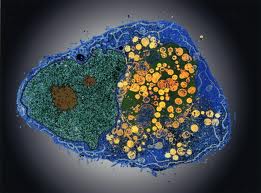导读:美国中佛罗里达大学研究人员结合纳米技术和DNA标记,开发出一种新型检测技术,能在几小时内出检测出与肠道炎症相关的多种病原体,包括克罗恩病等,为临床医疗带来一种快速精确的诊断工具。相关论文发表在9日的《科学公共图书馆·综合》上。

有些病菌在人体组织内隐藏得非常深,秘密地给细胞重新编程,躲过免疫系统攻击并在体内潜伏多年,突然爆发后会导致严重疾病,如肺结核。怎样找到它们的藏身地,长久以来困扰着科学家。现有的诊断隐秘细菌的方法通常要几周甚至几个月,这可能会延误治疗。
新型检测工具是一种混合磁驰豫纳米传感器(hMRS),只有一根发丝的厚度,由一层涂有聚合物分子的氧化铁纳米粒子构成,通过化学修饰会与特定的DNA标记结合,一种DNA标记专门针对一种特殊的病原体,即使病原体的数量很少,也能把隐藏在生物体深处的病原体找出来。
研究人员采集了大量克罗恩病患者的血液和活组织样本,以及患有牛副结核性肠炎的牛组织样本,对其病原体MAP(禽分支杆菌副结核亚种)进行了检测。一旦混合磁驰豫纳米传感器与病原体DNA结合,就会发出磁共振信号,信号被围绕纳米粒子的水子放大,通过计算机屏幕或便携式电子设备(如智能电话)就能读出磁信号的变化,确定样本有没有被感染。
中佛罗里达大学医学院教授莎拉·纳瑟介绍说,混合磁驰豫纳米传感器能测出隐藏在病人细胞内的微量病原体DNA的数量。“这种新技术比传统的分子和微生物方法更有优势,同时保留了特异性和灵敏性。而且以往要耗时几个月的检查,现在只需几小时就能得出可靠而精确的结果。”
“该技术为医疗专业人员提供了一种简易可靠的工具,能更好地研究疾病的传播,帮助病人更及时地获得有效治疗。”该校纳米科技中心副教授·曼纽尔·皮尔茨说,“尤其在检测医疗、食品、环境样本中,正是纳米技术发挥优势的地方。”
美国国家综合医学研究所的简娜·韦尔利博士指出,基础研究能带来基础性的医疗突破。研究小组去年尚未发现DNA具有和磁共振传感器结合的性质,但今年就已经开发出了快速灵敏地检测隐蔽细菌和病毒的技术,这也表明了一项先进技术从实验室研究到满足重大医疗需求有多快。

Rapid and Sensitive Detection of an Intracellular Pathogen in Human Peripheral Leukocytes with Hybridizing Magnetic Relaxation Nanosensors
Charalambos Kaittanis, Hamza Boukhriss, Santimukul Santra, Saleh A. Naser, J. Manuel Perez
Bacterial infections are still a major global healthcare problem. The quick and sensitive detection of pathogens responsible for these infections would facilitate correct diagnosis of the disease and expedite treatment. Of major importance are intracellular slow-growing pathogens that reside within peripheral leukocytes, evading recognition by the immune system and detection by traditional culture methods. Herein, we report the use of hybridizing magnetic nanosensors (hMRS) for the detection of an intracellular pathogen, Mycobacterium avium spp. paratuberculosis (MAP). The hMRS are designed to bind to a unique genomic sequence found in the MAP genome, causing significant changes in the sample’s magnetic resonance signal. Clinically relevant samples, including tissue and blood, were screened with hMRS and results were compared with traditional PCR analysis. Within less than an hour, the hMRS identified MAP-positive samples in a library of laboratory cultures, clinical isolates, blood and homogenized tissues. Comparison of the hMRS with culture methods in terms of prediction of disease state revealed that the hMRS outperformed established culture methods, while being significantly faster (1 hour vs 12 weeks). Additionally, using a single instrument and one nanoparticle preparation we were able to detect the intracellular bacterial target in clinical samples at the genomic and epitope levels. Overall, since the nanoparticles are robust in diverse environmental settings and substantially more affordable than PCR enzymes, the potential clinical and field-based use of hMRS in the multiplexed identification of microbial pathogens and other disease-related biomarkers via a single, deployable instrument in clinical and complex environmental samples is foreseen.
文献链接:https://www.plosone.org/article/info%3Adoi%2F10.1371%2Fjournal.pone.0035326








